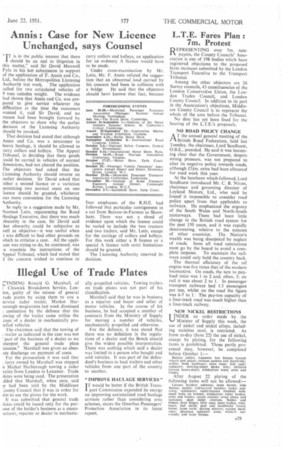L.T.E. Fares Plan : 7:11. Protest
Page 31

If you've noticed an error in this article please click here to report it so we can fix it.
D EPRESENTING over 7m. rate11. payers, the County Councils' Association is one of 198 bodies which have registered objections to the proposed fares increases submitted by the London Transport Executive to the Transport Tribunal.
Among the other objectors are 26 Surrey councils, 43 constituencies of the London Conservative Union, the London Trades Council, and London County Council. In addition to its part in the Association's objections, Middlesex County Council is to represent the whole of the area before the Tribunal.
No date has yet been fixed for the hearing of the L.T.E.'s proposals.
NO ROAD POLICY CHANGE
AT the annual general meeting of the British Road Federation,. held last Tuesday, the chairman, Lord Sandhurst, 0.B.E., presided. He said it was becoming clear that the Government, despite strong pressure, was not prepared to alter its negative policy towards roads, although £3fm. extra had been allocated for road work this year.
At the luncheon which followed, Lord Sandhurst introduced Mr. C. B. Nixon, chairman and governing director of Leyland Motors, Ltd., who said he found' it impossible to coasider road policy apart from that applicable to railways. He emphasized the urgency of the South Wales and North-South motorways. There had been little change in the British road system for the past 150 years, and it was rapidly deteriorating, relative to the systems of other countries. The Nation's wealth was being dissipated by neglect of roads. Soon all road restrictions must go by the board to avoid a complete impasse. To maintain the railways could only hold the country back.
The thermal efficiency of the oil engine was five times that of the modern locomotive. On roads, the tare to payload ratio was 1 to 2 and, often, 3; on rail it was about 2 to I. In passenger transport railways had 1.3 passengers per ton, whilst on the road the figure was 6-7 to ls The pay-ton capacity of a four-track road was much higher than a four-track railway.
NEW NICKEL RESTRICTIONS
UNDER an order made by the Minister of Supply this week, the use of nickel and nickel alloys, including stainless steel, is restricted. As from to-day (June 22) the use of nickel, except by plating, for the following items is prohibited. Those partly processed may, however, be completed before October 1:— Battery cables; bumpers; bus Pilings (except wheels and axles); exhaust gaskets and manifolds; grilles; body hardware; horn rings: hub cap5; radiators; steering-wheel spoke wire; silencers (except heavy-duty); Windscreen wiper arms and blades.
After August 22 plating of the
following items will not be allowed:— Licence holders; ashtrays; lamp bezels; trim flashes; motifs; sliding-roof handles; locks: supports; ventilators; under-bonnet terminal nuts; small bolts on bonnet; windscreen wiper bushes, arms and blades; carpet retainer tread plates and fasteners; dash panel controls, flashes and hinges; door binges; filler caps; lamp bodies, rims, bases, ball shells; gear and handbrake levers; horns; loose cooly driving mirrors; seating hardware; direction indicator arms; window surrounds; and body fittings.




















































































